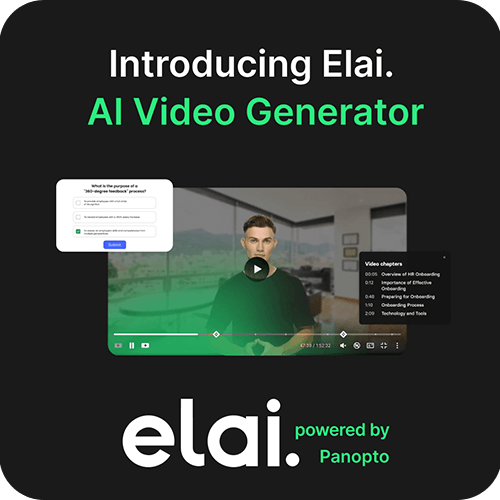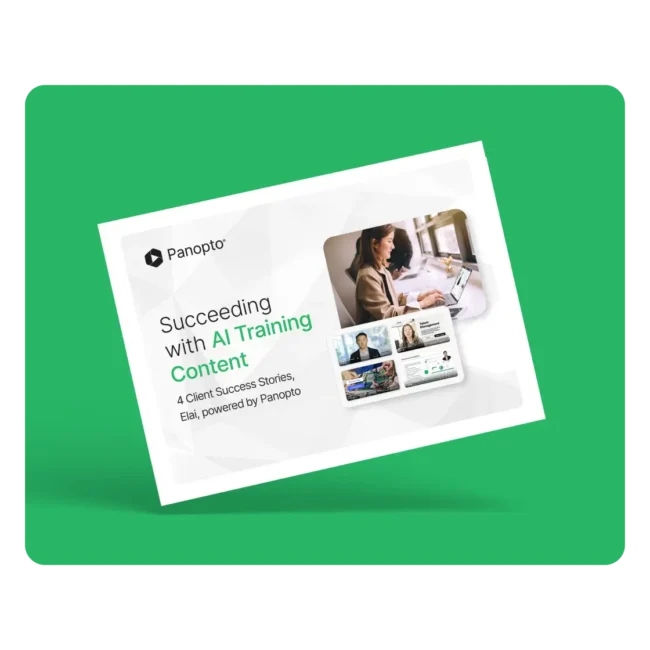- Academic Technology
4 Types of Videos For More Engaged eLearning
If you’re an instructor in higher education or a trainer in a corporate environment, there’s a good chance that the way you work has changed more in the last ten years than it had for in the last one hundred for your predecessors.
After centuries spent honing a handful of models of in-person lecture and instruction, a host of new technologies have today brought forth many new changes and options for all of us in the learning space — from entire new pedagogies like flipped learning, down to new tactical tools like video.
Elearning videos, in particular, have become a cornerstone of many blended course designs. Lauded by scholars as an effective educational tool and increasingly preferred by learners who have grown up in the age of YouTube, elearning videos offer the ability to deliver a uniquely immersive learning experience for almost any concept or skill.
Of course, this doesn’t mean that video-based elearning is some sort of silver bullet for educators, as much as we might like it to be.
Watching a video can be a passive experience, too. A dry, hour-long lecture that fails to engage learners in person will fare no better when recorded (especially if the room itself isn’t captured and learners can replay only the slides paired with voiceover audio).
Fortunately, there are any number of strategies instructors can use to make their recorded content both more engaging and more valuable as part of their blended, flipped, or other active learning approaches.
So what are the secrets to creating elearning videos that enhance the learning experience?
Best Practices For Designing Engaging eLearning Videos
In 2015, The Center for Teaching at Vanderbilt University examined several meta-analyses and multiple studies on video-enabled learning. They then used their insights to develop a set of recommendations for producing effective educational video content, which include the following:
- Signaling: Use on-screen text or symbols to highlight important information and direct the learner’s attention. For example, signaling may be provided by the appearance of two or three keywords, a change in color or contrast, or a symbol that draws attention to a region of a screen like an arrow.
- Segmenting: Structure information into chunks. This allows learners to engage with small pieces of new information while also giving them control over the flow of new information. In practice, an instructor might choose to break a course into shorter videos, or purposefully add breaks between segments in longer videos with a question or a quiz.
- Weeding: Eliminate interesting but extraneous information from the video, specifically, information that does not contribute to the learning goal. In other words – keep it simple. Minimize the use of music, complex backgrounds or animations that can distract the learner.
- Matching Modality: Give the learner complementary streams of information to elucidate a new concept. One example of this is a video that shows the presenter speaking in one part of the screen and their supporting slides in another part of the screen. Another video might show the instructor demonstrating a process on the screen while narrating. Using both channels to convey appropriate and complementary information not only increases student engagement but has also been shown to increase students’ retention and ability to transfer information.
Advances in video software for elearning has made is easier than ever to record videos that follow best practices. Not only can the right software make it easy to record multiple audio and video streams with minimal clutter, but they also include simple video editing tools, and the ability to add interactive elements like quizzes or embedded videos from YouTube.
Related Reading: 7 Ways An Video Platform Streamlines eLearning Authoring
4 Most Common Types of eLearning Videos
Instructional designers are always experimenting with new methodologies and techniques intended to improve learning. As a result, e-learning videos are often as unique as the instructors themselves. But over the last several years a few themes have emerged in some the most common types of elearning video formats that follow the best practices for creating engaging videos outlined above.
1. Instructor-Led Lectures And Training
Instructor-led lecture and training videos are one of the most common types of e-learning videos, since they are essentially the video version of live, in-class instruction. And while there are many different possible ways to record these types of videos, there is an optimal format that best supports learner engagement. Instructor-led videos should show the teacher presenting, along with their supporting learning content such as slides or a screen share.
Watch an example of an instructor-led training video below:
2. Demonstrations
Recording live demonstrations have the power to show students how to do something in a much more powerful way compared to telling them or showing them static pictures or drawings. For multi-step processes and things that require physical action, elearning videos that demonstrate how to do it along with a narration can, in some instances, be more helpful than watching a demonstration in person.
In a video, learners have the power to pause, rewind, and slow down the playback speed if they didn’t catch it all the first time. In addition to the learner’s ability to control playback, multiple camera angles have the potential to give them a better, more detailed view than they could possibly have in person.
Watch an example demonstration video below:
3. Scenarios and Simulations
Video is an extremely useful and efficient medium for capturing scenarios and simulations that show various situations a learner may encounter when applying specific training. Learners can even be recorded performing their own scenarios, which they can then watch to critique their own performance.
Scenario and simulation videos are often used to prepare nursing or medical students for patient interactions, for showing scenarios in a mock courtroom, and for teaching new managers soft skills like handling difficult conversations. These elearning videos can bring the real world into the classroom, giving students valuable understanding of new concepts at a much deeper level that better prepares them to use their new skills.
Watch an example of a simulation video below:
4. Learner Generated Videos
Learner generated elearning videos can include not only informal training from colleagues at work, but also videos created by students in which they practice the skills they’ve learned. It’s a different way to think about elearning video content, but learner generated videos can be just as powerful as formal elearning videos.
In higher education, students can record themselves practicing communication skills or speaking a foreign language. The added benefit to recording themselves practicing is that instructors are able to preserve valuable in-class time for instruction and also provide individual feedback to students. Read how the University of British Columbia’s Sauder School of Business used learner generated videos to better prepare MBA students for communicating in the workplace here.
In the workplace, social learning has begun to emerge as a valuable and scalable solution for knowledge sharing. Subject matter experts, or any employee really, record themselves demonstrating a new process or walking through a training they might normally give one-on-one and share those videos with the entire team or organization.
Watch an example of a learner generated elearning video below:
What’s Next in eLearning?
As instructional design in education evolves with technological advances, the types of elearning will undoubtedly evolve as well. For example, many educators predict that augmented and virtual reality will completely transform the way students learn by immersing them in actual experiences and simulations. Nevertheless, experts agree that video-based learning is one of the most engaging and effective methods of teaching — not only now, but also in the future.
Try The Video Software Designed For eLearning
Developed at Carnegie Mellon University and used at 21 of the top 25 universities in the world, Panopto is the leading video platform for supporting e-learning. Record and edit e-learning videos, make them searchable, and share them securely with your students with one easy-to-use video tool.



